24 August 2022
‘What does digital storytelling look like?’ with Toolkits: Digital Storytelling facilitator Rory Green
Digital storytelling can refer to a sea of unique forms of multimedia and interactive writing. From hypertext poetry to interactive fiction, podcasting and multimedia essays, it’s hard to know where to start!
Ahead of this year’s Toolkits Connect: Digital Storytelling, program facilitator Rory Green shares some of the eclectic work that have shaped how they think about digital storytelling.
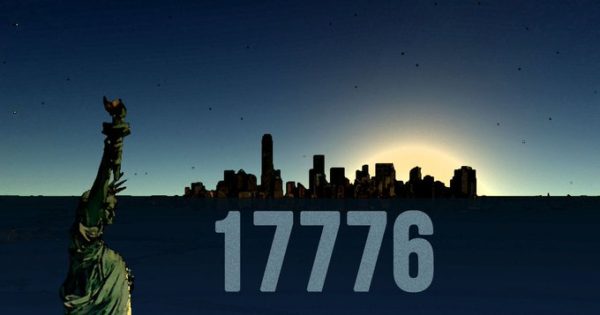
17776 / What Football Will Look Like in the Future – Jon Bois
This was one of the first creative pieces on the web that I read and was properly taken aback by. It’s so weird and moving and utterly unique! I had never heard the terms ‘digital storytelling’ or ‘electronic literature’ at that point, but I just knew I loved the vibe and was curious whether there was anything else like it. It’s hard to say too much about this piece without giving it away, so I encourage you to just dive in and enjoy the ride.

novena – Cecile Richard
I’m obsessed with all of Cecile’s narrative games: from the sci-fi grief of under a star called sun to the more realist look at digital intimacies in topography, their use of popular small-game tool Bitsy to create these touching personal stories has long been so impressive to me. For me, novena is where it all started – it was my first experience with Cecile’s work and with the Bitsy tool! I am still learning neat little tricks about storytelling and pixel art from this game after many years.
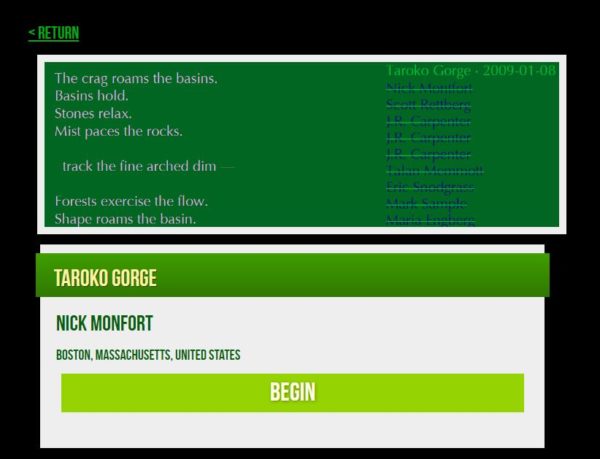
Taroko Gorge – Nick Montfort
Nick Montfort’s naturistic poetry generator Taroko Gorge has inspired dozens of ‘remixes’ since it was first published – the relatively accessible code structure invites others to tinker with it and transform its context. I came to this poem somewhat late, after I had first started making generative poems like futurity blues with the software library Tracery. It was immediately obvious though that this was basically the blueprint for all of the writers and artists I was admiring and attempting to emulate at the time (the placement of a missing puzzle piece for my creative practice!)

Things We Inscribed in the Voyager Golden Record – Shastra Deo
I have been a fan and friend of Shastra for a few years now, and I’m always awed by the varied digital literary works they produce. This interactive poem is one of my all-time favourites: it’s so sharp and elegant, and the way image and text are interwoven in this piece is a continual source of inspiration for me. For the best experience I recommend reading it on a computer, so you can interact with it via computer mouse.
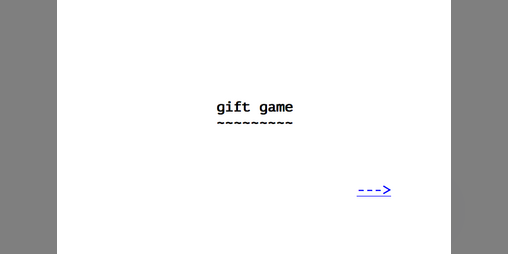
Gift Game – Everest Pipkin
Last year I was lucky enough to be able to commission Everest for the GAME issue of Cordite Poetry Review, publishing their expandable poem-essay Soft Corruptor. I was so nervous, I must have reworded my cold email at least 20 times! Everest is just a superstar artist to me and their art has shaped me so much since I started writing specifically for a digital medium. Gift Game has been the most influential: it’s a deeply moving manifesto on archives, friendship and what telling stories in digital forms is/can/should be for. This game changed the way I interact with others online, and its themes can be felt throughout all of the Toolkits: Digital Storytelling program.
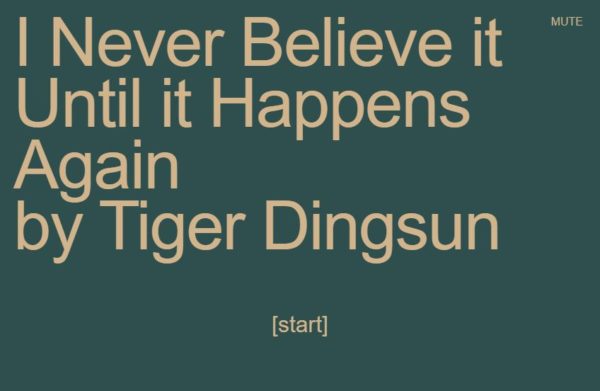
I Never Believe It Until It Happens Again – Tiger Dingsun
Tiger Dingsun’s Reading Machines project is ridiculously cool. It’s a digital publication reimagining writing for ‘non-teleological reading’: the poems and stories Tiger has published here scatter, cascade, meander across the web page. My favourite of these is one of Tiger’s fully original pieces, which I have written about extensively in a recent residency. Within the chaotic orchestra of fragmented words, Tiger tells a powerful story about struggling to maintain stability amidst a turbulent period in one’s life. Picking apart this work has taught me a lot about HTML, CSS and JavaScript – the three code languages that underlie all websites and provide many cool opportunities for interactive writing on the web.
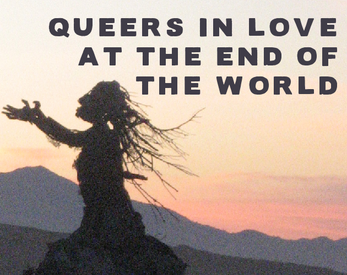
Queers in Love at the End of the World – Anna Anthropy
This piece is extremely popular, and for a good reason! It’s a perfect example of digital-first storytelling for me. The interplay between the story’s themes and the timer mechanic is ingenious, and every time I replay this game I am emotionally torn apart and put back together again.
If you’d like to learn how to make digital stories like the ones Rory has shared here, apply for Toolkits Connect: Digital Storytelling! Applications are open until Sunday 28th August 11:59PM AEST



